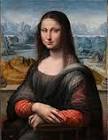Leonardo da Vinci’s painting “Mona Lisa” is perhaps the most famous work of art in the world. I’ve never quite understood why, perhaps because of the enigmatic smile? (An artist friend once told me Leonardo used that smile in many of his paintings.) In any event, its fame begs the question, who was the model?
 According to The Writer’s Almanac, she was Lisa del Giocondo, born Lisa Gherardini in Florence, Italy on June 15, 1479. Her Almanac entry is as follows —
According to The Writer’s Almanac, she was Lisa del Giocondo, born Lisa Gherardini in Florence, Italy on June 15, 1479. Her Almanac entry is as follows —
We don’t know much about her childhood, but we know that when she was 15, she married a wealthy silk merchant nearly twice her age. She didn’t have a rich dowry, and most girls in her situation would not have found husbands but would have been sent to a convent, unless her family had political connections or other advantages. Lisa’s advantage was that she was beautiful, and Francesco del Giocondo was captivated by her. He arranged to marry her for a piece of her father’s farmland, and their marriage seems to have been a happy one. Francesco’s will specifically mentions her noble spirit and her faithfulness, and speaks of his love and affection for her.
In about 1503, Francesco commissioned an esteemed local artist named Leonardo to paint his wife’s portrait — possibly because the couple had just bought their house, or perhaps it was to commemorate the birth of their second son. Leonardo usually painted aristocrats, but he was between jobs at that time, and was hopeful that Francesco’s political connections could help him get some big commissions. The canvas he selected was quite large for a portrait of this type, and he also made the decision to “zoom in” pretty closely on the sitter. It seems like a small thing, but was actually revolutionary, and his choice had an immediate influence on other artists of the region. Leonardo was working on the portrait when he received a lucrative commission to paint The Battle of Anghiari — a joint project with Michelangelo to decorate the Palazzo Vecchio — so he set it aside. He took the unfinished portrait with him when he left Florence, and never delivered it to Francesco and Lisa — possibly because Francesco never paid him. Leonardo finished the portrait eventually, and it wound up in the hands of the French king Francis I.
That portrait was, of course, the Mona Lisa, and 6 million people view it at the Louvre every year. We didn’t know anything about its subject until 2005, when an expert at the University Library of Heidelberg discovered a note in the margins of a record book. The note referred to a portrait that Leonardo da Vinci was painting of Lisa del Giocondo, around the time that the Mona Lisa was known to have been painted. It gave investigators something to go on, but women’s lives were mostly unremarked upon in the early 16th century — their births, marriages, and deaths were recorded, and the baptisms of their children, but that’s about it. Journalist Dianne Hales took up the challenge and found out everything she could about the mysterious Lisa. She published her findings in Mona Lisa: A Life Discovered (2014). Hales writes: “Lisa’s life spanned the most tumultuous chapters in the history of Florence, decades of war, rebellion, invasion, siege, and conquest — and of the greatest artistic outpouring the world has ever seen.”
Francesco died in 1528, and Lisa died about four years later. She is reportedly buried at the convent of Sant’Orsola, where her daughter Marietta was a nun.
The Writer’s Almanac with Garrison Keillor for June 15, 2017 can be found at http://writersalmanac.org/page/9/ . The photo came from Google.
